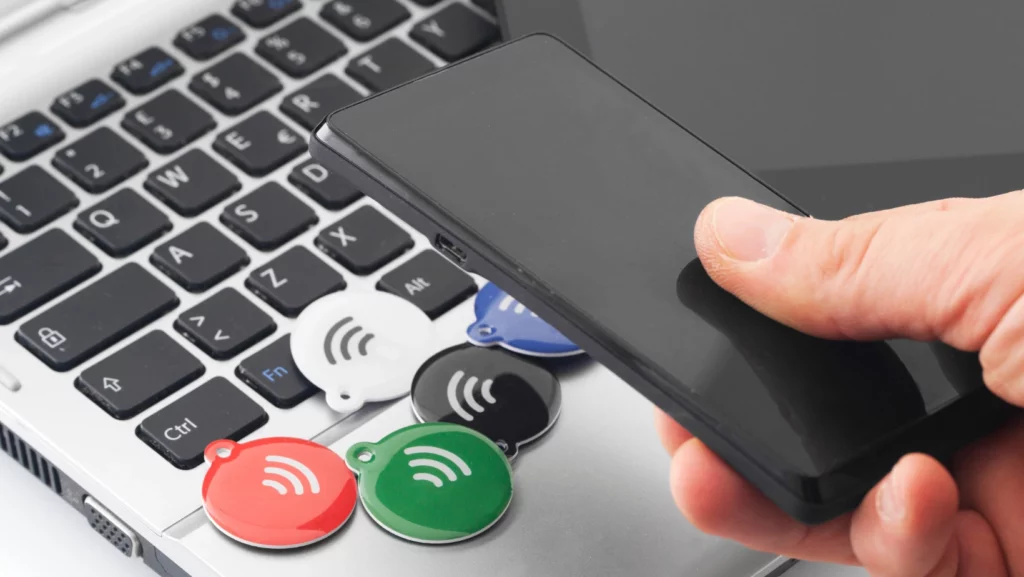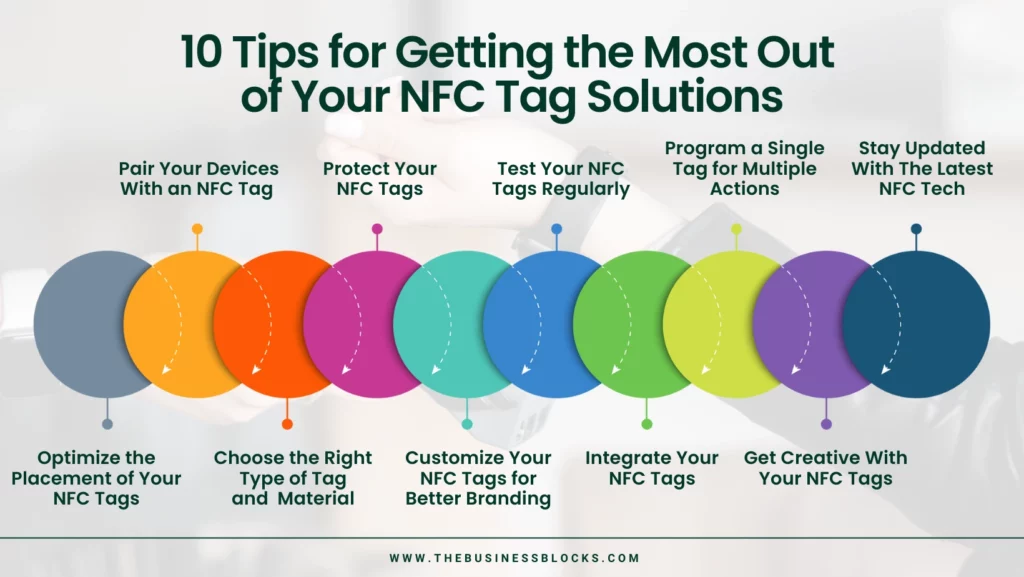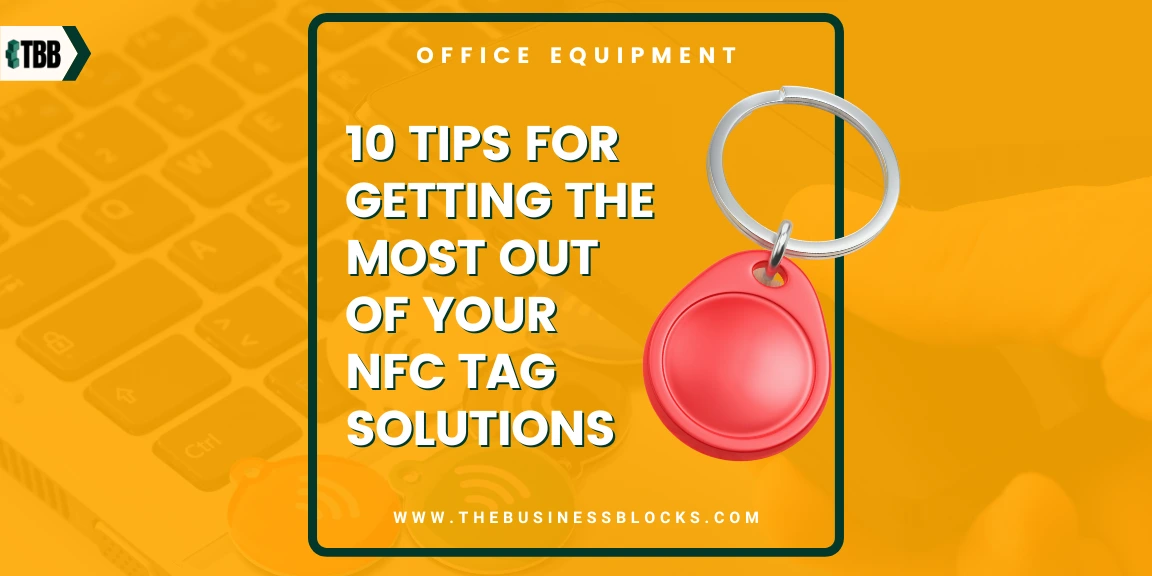Today, it won’t be wrong to say that we live in a world of continuous technological development. New and innovative technology pops up almost daily, making our lives simpler and more connected. One such technology that seamlessly blends into all our lives is NFC tags.
NFC tags or Near Field Communication (NFC) technology has become incredibly common with the rise and worldwide adoption of smart devices. It has made the data exchange between two smart devices simpler and quicker.
In this blog post, we will explore more about this technology, how it works, and what can you do with NFC tags. Let’s get started!
Are you looking for ways to Maximize your NFC tag solutions?
Unlock the power of Near Field Communication technology with these 10 expert tips. You’ll learn essential best practices to get more out of your tags and ensure each one works as efficiently and effectively as possible. These tactics will help you save time, money, and energy when setting up, maintaining, and utilizing NFC solutions for everything from contactless payments to loyalty programs.
With these tips in hand, you’ll be able to get much more value out of your existing NFC tag deployments – while teaching yourself a few tricks along the way. From beginner-level advice that helps streamline processes across departments through advanced concepts designed for experts only – this guide has it all!
What Exactly Are NFC Tags and How Do They Work?

Simply put, NFC, or New Field Communication, is a technology that enables two smart devices to interact wirelessly. NFC tags are intelligent tags that leverage radio waves to share data between nearby devices.
While NFC tags come in various shapes and sizes, you can often find them as small rectangular or circular stickers. They contain a copper coil, an embedded microchip, and an antenna.
Today, almost every smartphone, tablet, etc., comes with an NFC reader. So, when you use NFC technology, this happens: the NFC tag and the NFC reader (on the NFC-enabled device) work together to exchange data. The tag sends radio waves that activate the antenna in the receiver’s NFC-enabled device. Once the user validates the connection, the devices can share data seamlessly.
Advantages and Disadvantages of Using NFC Tags
Now that we have a basic understanding of NFC tags, you must know their pros and cons. While they enable you to share data with another device easily, they have some shortcomings.
That said, let’s look at these tags’ significant advantages and disadvantages.
Advantages:
- Seamless connectivity: NFC tags make linking devices with a single tap super easy. You can quickly share information, connect to Wi-Fi, pair Bluetooth devices, or launch different actions with another nearby device. No need to go through complicated setup steps!
- They are versatile: A major benefit of using these tags is their versatility. From making mobile payments to smart home automation, these tags have various uses and can be deployed in various fields.
- Wireless data exchange: NFC tags enable you to transmit data wirelessly. They don’t require any power source or physical connectivity to work.
- Incredibly cost-effective: Another major benefit of NFC tags is that they are very cost-effective. This makes them suitable for all kinds of uses and for everyone – from individuals to businesses.
Disadvantages:
- Limited range: One of the shortcomings of NFC tags is that they can operate within a limited range, usually not more than 4 to 5 centimeters. This restriction forces users to bring their devices close to the NFC tag for it to work.
- Security-related concerns: Although NFC tags come with security features like encryption, there’s always a risk of unauthorized access or data interception. So, this can be a possible concern for people who use this technology to transfer sensitive data and make payments.
10 Tips for Getting the Most Out of Your NFC Tag Solutions

Talking about what you can do with NFC tags, there are multiple things that you can achieve with these tags. From sharing URLs to making payments, NFC tags have simplified and quicker many tithings. However, you must know expert tips about using these tags efficiently to get the most out of these tags.
And that’s what this section is all about! Here, we will share our top 10 tips to help you use NFC tags as best as possible.
1. Optimize the Placement of Your NFC Tags
To get the most out of your NFC tags, it is crucial to place them at a strategic location. Consider the context and intended actions when deciding the best location for your tags. Make sure they are easy to find and visible. As a business owner, you can consider attaching these tags near entry points for quick access, placing them on product packages, etc., to create interactive experiences.
2. Pair Your Devices With an NFC Tag for Easy Access
Consider pairing your NFC-enabled devices with the NFC tags that you use frequently. This will help you streamline your interactions and access frequently used functions or settings with a tap.
3. Choose the Right Type of Tag and Tag Material
While you think about what can you do with NFC tags, don’t forget to also think about what you need it for. Consider the range, power, and how long it will last, then pick between active and passive tags.
Also, choose the right tag material that perfectly meets your needs. NFC tags are available in various materials like adhesive stickers, keychain tags, or built-in tags. Choosing the right type and material will make sure your tag is up to the task and will last.
4. Take Necessary Steps to Protect Your NFC Tags From Unauthorized Access
It is essential to take all the necessary precautions to keep your NFC tags safe from unauthorized usage or tampering. For this, you should consider encrypting sensitive data stored on them, setting a password, or limiting write access to prevent unauthorized modifications. These security measures will ensure that your tags remain secure and are only used as intended.
5. Customize Your NFC Tags for Better Branding
As a business owner, you can take your NFC tags to the next level and promote your brand through them. You can make your NFC tags stand out by personalizing them with your brand. Consider adding a splash of your brand colors, including your brand logo, or using tag designs that capture the essence of your brand. Customizing your tags is a great way to give them an extra special touch and make a good impression on your customers.
6. Test Your NFC Tags Regularly
To get the most out of your NFC tags, it is crucial to maintain and test them regularly. Ensure the tags are readable and responsive and that your data is intact. If any of your tags are worn out or damaged, replace them quickly. Doing so is necessary to ensure that the NFC tags work properly and deliver consistent performance.
7. Integrate Your NFC Tags With Our Popular Technologies
NFC tags offer countless possibilities today. You can make your life easier by integrating these tags with other technologies that you commonly use. This will enable you to unlock new possibilities and create more sophisticated solutions.
For example, you could combine NFC tags with IoT devices like smart locks or home sensors to create comprehensive automation systems. It can help you enhance the functionality and capabilities of you these devices.
8. Program a Single Tag for Multiple Actions
Another excellent way to get the most out of your NFC tags is by programming multiple actions on one. So, instead of having separate tags for different tasks, you can leverage the power of a single tag to set off a series of actions. For example, you can program a single NFC tag in your car in such a way as to start up your go-to music playlist, turn up the volume, and get your GPS going.
9. Get Creative With Your NFC Tags
Apart from using NFC tags for basic uses, you can consider thinking outside the box and getting creative. For example, you can integrate NFC tags into marketing campaigns, create interactive exhibits or displays, or enhance product packaging with additional digital content.
10. Make Sure to Stay Updated With The Latest NFC Technological Advancements
Finally, stay informed on the newest developments in NFC technology. Learn about the new features, standards, and compatibility updates to use these new capabilities. You can join NFC-based forums, stay connected to the community, attend industry events, and follow reliable sources to stay updated about the latest developments.
3 Excellent Real-Life Examples of Businesses Using NFC Tags Creatively
1. KFC’s ‘Hot Shots Meal Box” Promotion Campaign
KFC’s famous fast food joint launched a promotional ad for its ‘Hit Shots Meal Box’ in the UK. For this, the company used NFC tags on posters and placed them in highly visible outdoor locations. Upon touching the NFC tag, the customers were shown a map that directed them to their nearest KFC outlet.
2. Adidas’s “Tap to Learn” Campaign
Adidas, the incredibly popular shoe brand, placed NFC tags on their running shoes. The customers needed to have an HFC-enabled smartphone. When they tapped the tag, it redirected them to the product information page, where they could read about the particular shoe on their phone.
3. Lexus’ NFC-Powered Print Ads
The luxury carmaker, Lexus, used NFC-embedded print ads for advertising their cars in Wired Magazine. The readers can tap on the NFC tag that was attached to their advertisement to open a new app suite and learn more about the vehicles.
What Are the Future Applications of NFC Technology
Since the NFC technology offers so many exciting possibilities and the big brands have already started leveraging these tags, the future is quite bright for them. That said, here are some potential future applications of the NFC technology:
- Use of NFC technology in the healthcare sector: NFC has the potential to revolutionize healthcare. It can be used in wearable sensors, implantable devices, secure medical records, and patient identification cards. With NFC technology, data transmission, patient monitoring, and real-time diagnostics can be made easier.
- Worldwide adoption of smart ticketing: While many places worldwide have started using NFC tags for ticket booking, we can expect to see a rise. It is expected that people will be able to book tickets for movies, concerts, trains, etc., via NFC technology globally.
- The increased popularity of contactless payment solutions: In the future, we can look forward to more people using NFC-enabled digital wallets and making payments quickly and safely with just a tap. NFC could become the go-to way to pay, leaving behind the need for cards or cash.
Questions to Ask When Selecting an NFC Solution Provider
Before choosing your NFC provider, make sure to ask them the following important questions:
- What are the different types of NFC tags do you offer?
- What is your experience in the NFC industry?
- What is your process for handling security concerns and issues?
- Will you offer me ongoing support and maintenance services?
- Can you share the reviews of your past clients?
Important Things to Consider Before You Start
NFC device tags come in a variety of shapes and sizes. Make sure to understand the differences – and choose the size and type that best suits your needs.
1. Be mindful of your NFC tag solutions’ range and the environments they’ll be placed in. NFC card or NFC-supported devices are designed to work within about 5 cm of each other and need a clear path between the tag and device for optimal performance. While NFC business cards and keychain tags are ideal for indoor use, NFC stickers and labels can also be used outdoors.
2. Understand which tags are most suitable for the types of data you want to store and access. NFC chip tags typically store more data than low-frequency tags, making them a better choice for complex information and applications. One NFC tag or two NFC-supported devices can also transmit more complex data more accurately.
3. Create a plan for testing and verifying that your tags are working correctly with compatible devices or readers. For example, android phones and contactless payment systems may require an NFC-enabled mobile device to read and write data. Smart light bulbs or IoT devices may require an NFC-enabled reader to do the same.
These are just a few tips to get you started. From Google Maps to NFC business card and keychain tags, Program NFC tags and NFC tag solutions offer various possibilities for every application. Follow these best practices, and you’ll be able to get the most out of your NFC solution – no matter what type of data or application you’re using it for. With a little bit of research and planning, you’ll be able to experience all the benefits that NFC has to offer.
Frequently Asked Questions about 10 Tips for Getting the Most Out of Your NFC Tag Solutions
What can be done with NFC tags?
Wondering what can you do with NFC tags? These tags can make contactless payments, share information with a nearby device, book tickets, and more.
Can I add NFC to my phone?
To use NFC technology, you must have an NFC-enabled phone. You can download the NFC tools app from the App Store or Play Store to use the NFC functionality.
What is the distance range of NFC?
NFC has a limited range, usually between 1-4 centimeters (or less than two inches). This close range ensures that communication between NFC devices and tags is secure and reliable.
Does Google Pay and Apple Pay use NFC?
Both Google Pay and Apple Pay use Near Field Communication (NFC) technology to securely transmit payment information. Both apps support other contactless payment options, such as QR codes or barcodes.
Bottom Line
That was all about NFC tags and what can you do with NFC tags. We hope you found this blog post helpful and that we were able to answer your questions. To sum it up, NFC is a fast-growing technology, and we will see its widespread adoption in the future.

